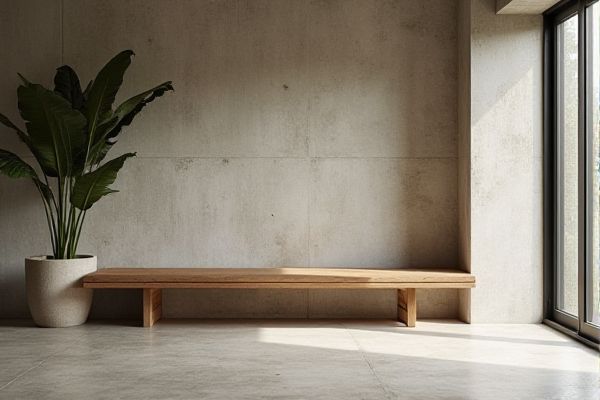
Concrete benches offer superior durability and low maintenance, making them ideal for outdoor spaces exposed to harsh weather, while wooden benches provide a natural aesthetic and warmth that blends seamlessly with garden environments but require more upkeep to prevent weather damage. Explore the benefits and drawbacks of each to discover which bench best suits Your outdoor seating needs.
Table of Comparison
| Feature | Concrete Bench | Wooden Bench |
|---|---|---|
| Durability | Highly durable, weather-resistant, lasts decades | Moderate durability, susceptible to rot and pests |
| Maintenance | Low maintenance, occasional cleaning | Requires regular sealing, staining, and protection |
| Weight | Heavy, permanent placement | Lightweight, easy to move |
| Comfort | Can be hard, cold; may require cushions | Warmer and more comfortable naturally |
| Cost | Usually higher initial cost | Generally lower initial cost |
| Design Options | Limited styles, mostly modern | Wide variety of styles and finishes |
Introduction: Concrete vs Wooden Benches
Concrete benches offer superior durability and low maintenance, making them ideal for outdoor public spaces exposed to harsh weather conditions. Wooden benches provide a natural aesthetic and comfort, with options in different wood types like teak or cedar that resist decay and offer warmth to the seating experience. Choosing between concrete and wooden benches depends on factors such as longevity, environmental exposure, and desired appearance.
Aesthetic Appeal and Design Versatility
Concrete benches offer a sleek, modern aesthetic with customizable shapes and finishes that enhance urban and minimalist landscapes. Wooden benches provide a warm, natural charm with versatile design options from rustic to contemporary styles, seamlessly blending into parks and gardens. Both materials support diverse design preferences, but wood excels in organic appeal while concrete stands out for durability and sculptural possibilities.
Durability and Longevity
Concrete benches offer exceptional durability and longevity, with resistance to weather, pests, and decay that can last over 50 years with minimal maintenance. Wooden benches, while aesthetically pleasing, are prone to rot, insect damage, and warping, typically requiring sealing or staining every few years to extend their lifespan. The robust nature of concrete makes it ideal for high-traffic public spaces where long-term durability is crucial.
Maintenance Requirements
Concrete benches require minimal maintenance due to their durability and resistance to weather, pests, and decay. Wooden benches demand regular upkeep including sealing, staining, or painting to prevent rot, insect damage, and weathering effects. Your choice should consider the time and resources you can dedicate to maintenance to ensure longevity.
Weather Resistance and Outdoor Performance
Concrete benches offer superior weather resistance due to their durability against rain, snow, and UV exposure, making them ideal for long-term outdoor use without significant deterioration. Wooden benches, while aesthetically pleasing, require regular maintenance such as sealing and staining to prevent moisture damage, rot, and insect infestation in outdoor environments. The thermal mass of concrete also helps it stay cooler in direct sunlight compared to wood, enhancing outdoor comfort and performance.
Comfort and Ergonomics
Concrete benches offer durability but often lack ergonomic design, making them less comfortable for prolonged sitting due to their hard, cold surface and rigid structure. Wooden benches provide greater comfort and support, as wood naturally adapts to body warmth and can be shaped with contoured seating to improve ergonomics. Your choice between concrete and wood impacts seating comfort, with wooden benches generally preferred for better ergonomic support and a more pleasant sitting experience.
Environmental Impact and Sustainability
Concrete benches have a higher environmental impact due to the carbon-intensive production of cement, contributing significantly to greenhouse gas emissions. Wooden benches, when sourced from sustainably managed forests, offer a renewable and biodegradable alternative with a lower carbon footprint. Choosing wood certified by organizations like FSC (Forest Stewardship Council) enhances sustainability by ensuring responsible forestry practices.
Cost Comparison
Concrete benches generally have a higher initial cost due to materials and labor but offer lower maintenance expenses and longer durability compared to wooden benches. Wooden benches typically have a lower upfront price but require frequent upkeep, such as sealing or painting, increasing long-term costs. Evaluating total cost of ownership reveals concrete benches as more cost-effective for public spaces and heavy use environments over time.
Ideal Locations and Applications
Concrete benches excel in outdoor public spaces like parks, plazas, and urban sidewalks due to their durability, weather resistance, and low maintenance requirements. Wooden benches are ideal for residential gardens, patios, and indoor areas where aesthetic warmth, comfort, and a natural look are prioritized. Both materials serve well in community areas, but concrete is preferred for high-traffic and exposed environments, whereas wood suits calmer, decorative settings.
Conclusion: Choosing the Right Bench for Your Needs
Concrete benches offer unmatched durability and low maintenance for outdoor public spaces, making them ideal for long-term use and resistance to weather elements. Wooden benches provide natural aesthetics and comfort, preferred for gardens and residential settings where warmth and style are prioritized. Selecting the right bench depends on factors such as durability requirements, environmental exposure, maintenance capacity, and the desired visual appeal for the installation site.
 homyna.com
homyna.com